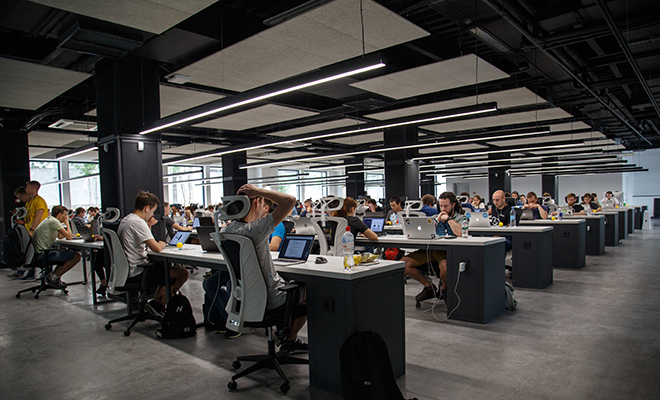In the fifth part in a series of posts about the ABC of Acoustic Design, we take a look at the principle of covering sound in the workplace and why the process of adding noise to reduce noise actually works!
“To cover up”.
The phrase invokes a feeling of dread, doesn’t it?
It’s not normally used in positive situations. You can cover yourself up, but then again, you’d only really do that when the temperature has dropped a few degrees and you need to put a jumper on.
Or, worse still, the phrase gets thrown around when there’s some kind of scandal that’s been brushed under the carpet.
Yet when it comes to sound, covering it up is really beneficial.
In offices, background noise is generally quite low.
This means it’s really easy for people to overhear conversations and all those other workplace annoyances (such as eating and listening to annoying, repetitive, generic music.)
This is crucial because evidence states that employees take around 20 minutes to regain concentration after being distracted.
Scale that figure up across the entire workforce and you’re looking at countless days and months that are lost to everyday things like telephone calls, passing traffic and overly talkative colleagues.

In this series, we’ve previously looked at absorbing and blocking sound in the office. Yet with the rise of open plan spaces, such solutions might not be feasible.
Alternatively, you might want to install a sense of balance across the workplace, where all working zones have a similar ambient noise level.
In both these scenarios (and many, many more), covering up – or masking – sound is the way to go.
We admit that the concept of sound masking does come across as a little counterproductive.
There has been the odd occasion that when we confidently say “by adding sound, you can make a space seem quieter”, we get met with quizzical looks and a quick-fired retort of “and what did you have for breakfast this morning?”
However, when we explain the principle in a little bit more detail, those puzzled eyes brighten up. Here’s why…
The next time it’s dark, take a look outside.

With a little bit of luck, you’ll see the stars shining away in the night sky. Fast forward a few hours and when dawn breaks, those stars appear to dim as the sun rises. Those stars that shined so bright throughout the night are still there, they just aren’t visible because the ambient light has increased.
It’s the same principle when it comes to sound masking – by adding ambient sound to a space, you can hide sound in plain sight. Or in plain earshot, if you like.
The way it works is ingenious too. The noise that a sound masking system distributes is akin to that of an airflow, or an air conditioning unit, and is specially formulated to match the common frequencies of human speech.
In practice, this means that once you’re attuned to it, it effectively acts as a blanket, making conversations across the office less conspicuous.
Crucially, because your brain can’t decipher the words floating through the air, you’re less likely to be distracted. In fact, depending on how close you are to the source of the chatter, you probably won’t even realise that Accounts are animatedly discussing last night’s goings on.
It’s important to note, however, that sound masking is very different to white noise.
There’s a common misconception that the two are similar when the reality is they couldn’t be further apart. When tuned and configured properly, sound masking should be inconspicuous – even when amplified.
Again, this is due to its specially designed composition to match human speech. In comparison, white noise, when played at a high volume, is extremely irritating. That’s because white noise contains a variety of frequencies all outputted at an equal level and the end result is akin to radio static (for those that remember life before digital).
Sound masking works exceptionally well in the office because it reduces distractions and protects speech privacy – two of the biggest disruptors and bugbears in the workplace. It’s not a cure-all but it’s a highly effective acoustic solution, one that when configured correctly, can exponentially enhance workplace productivity.
In short, sound masking is a solution that needs to be heard to be believed. Let’s cover up your next project and make it an acoustically perfect workspace.